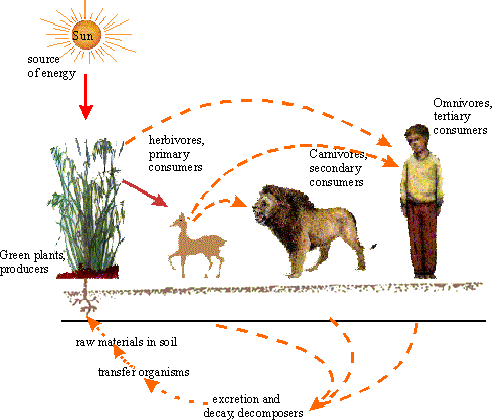|
PinkMonkey Online Study Guide-Biology
25.1 Species
A species is the smallest unit of taxonomy. It
may be defined as a group of interacting and interbreeding individuals
which closely resemble each other and breed to produce fertile offspring
and have common ancestry. For example man (Homo sapiens), frog (Rana
tigrina), china rose (Hibiscus rosa -sinensis) and sunflower (Helianthus
annuus) are different species. Some individuals of different species
may cross-reproduce "hybrids" but they are sterile or
short-lived, e.g. a mule, which is a hybrid of horse and donkey.

Click here for enlargement
25.2 Interaction between biotic and abiotic factors
However, morphological differences called variations
may exist within individuals of the same species, e.g. drone,
worker and queen of honey-bees. Similarly, the flowers of the 4
o’clock plant (Mirabilis jalapa) may be red, yellow or pink, and
those of Bougainvillaea are red, pink, orange or white. These are
not different species but variations between the same species.

Fig. 25.3 Morphological variation in honey bees
Population
A population is defined as a group of interacting
and interbreeding organisms of the same species inhabiting a particular
area at a particular time. A population, however, is not merely
a physical group of organisms but forms the unit of an ecosystem
which exhibits certain properties not shown by the individual
members of the group. For example, it has a birth rate, growth rate
and death rate, whereas an individual is born and dies but does
not have a birth rate or death rate. Examples of these "collective
properties" of a population are cited below :
(1) Density (2) Natality (Birth
rate)
(3) Mortality (death rate) (4) Age distribution
(5) Sex-ratio
Density : Is the total number of individuals
living per unit area or unit volume at a specific time. It is one
of the important parameters of a population.
With reference to human beings, the density of
the population is calculated with the help of the following formula
:
D = n/a where D = density
n = number of individuals
a = area in square kilometers
Population density depends on environmental conditions,
natality (birth rate, mortality, death rate), natural resources, emigration
(outward movements or flow), immigration (inward movements) and reproduction.
Distribution of individuals in a population may be random
or irregularly scattered, clumped or aggregated in groups, or uniform,(i.e.
evenly distributed).
Interaction between environment and population
There is always interaction between the environment and
a population. A population is limited by environmental factors such as
food supply, predators and shelter and nesting area. These physical and
biological factors which limit growth of a population is called environmental
resistance. Without environmental resistance, for instance,
oceans would be full of fish which lay about 8 million eggs every year,
and the fields would be full of rabbits. When a species is first introduced,
environmental resistance is usually low but when its population enormously
increases, the environmental resistance also increases in the form of
predators, competition between the members for food, space and shelter,
etc. For example, when the rabbit was first introduced into Australia
and the English sparrow was brought to the United States, initially their
populations increased enormously but later on were brought under control
by environmental resistance.
[next page]
|
Table of Contents
25.0 Introduction
25.1 Species
Chapter
1
|